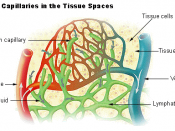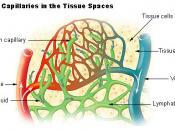Compare the Circulatory system and the Lymphatic system
Closely connected with the blood and circulatory system, the lymphatic system is an extensive drainage system that returns water and proteins from various tissues back to the blood stream.
When blood reaches the arterial end of the capillary beds in the body tissues, fluid from the plasma is forced out of the capillaries by the blood pressure in to a space between the capillaries and the tissue cells. This fluid, called tissue fluid, is plasma that has permeated through the blood capillary walls and has surrounded the cells to bring them nutrient and to remove their waste substances. Tissue fluid is an aqueous solution containing glucose, amino acids, fatty acids, inorganic ions, oxygen and hormones, which diffuse into the tissue cells to carry out the metabolic reactions.
Most of the tissue fluid, now containing fewer nutrients and less oxygen but more carbon dioxide and metabolic waste products, passes back into the venous end of the capillary network and then back to the heart.
The small amount of Tissue fluid that remains is picked up by tiny vessels called the lymph capillaries. The cells forming the walls of the lymph capillaries are loosely fitted together, thus making the wall very porous. Even the large serum proteins that filtered through the capillary wall pass easily from the tissue fluid into the interior of the lymph capillary. The lymph capillaries drain into still larger vessels that make up the lymphatic system. The flow through the lymph vessels is quite slow. The lymphatics resemble the veins in their structure having;
1)An outer coat of fibrous tissue
2)A middle coat of muscular elastic tissue
3)An inner lining made up a single layer of epithelial cells
Also like the blood in the veins, contraction of skeletal muscles...



Great
A very good essay with a lot of information given in a quite fast pace.
0 out of 0 people found this comment useful.